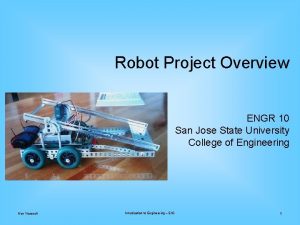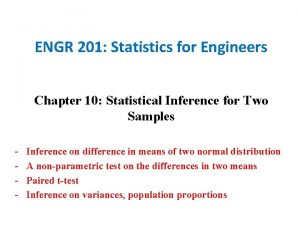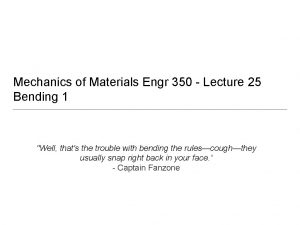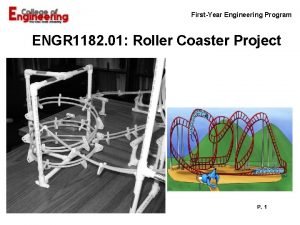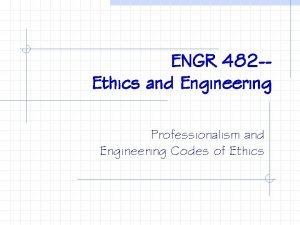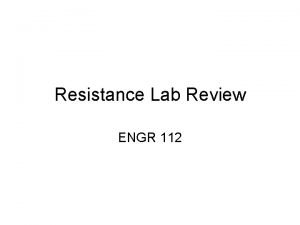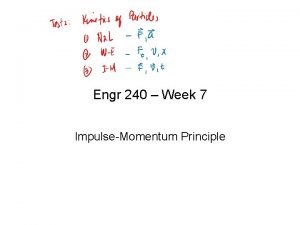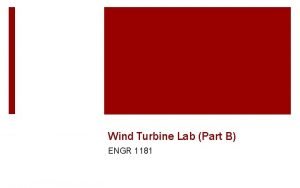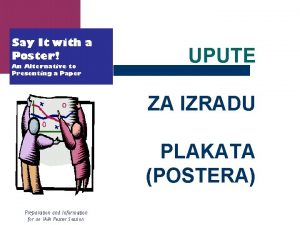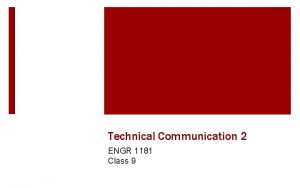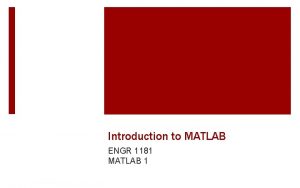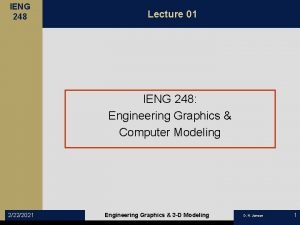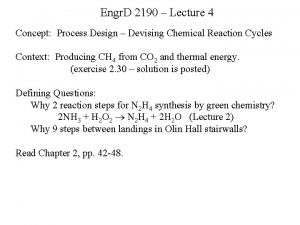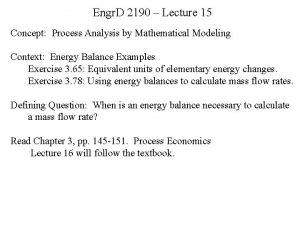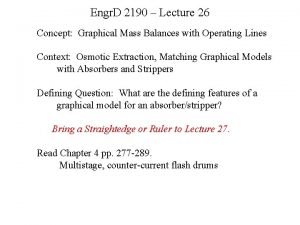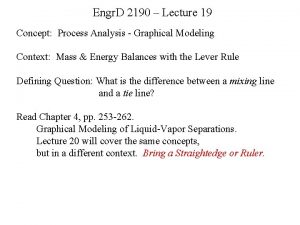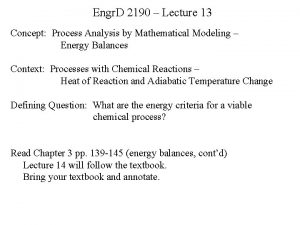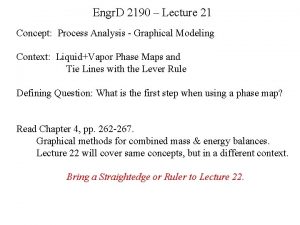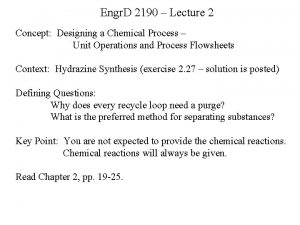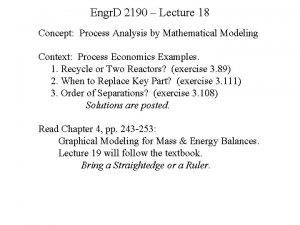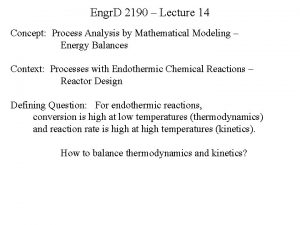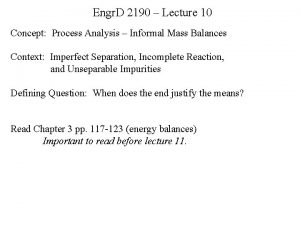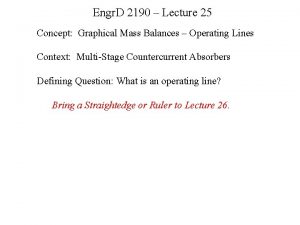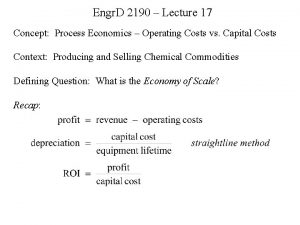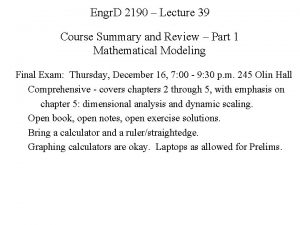Engr D 2190 Lecture 3 Concept Design Creative


















- Slides: 18

Engr. D 2190 – Lecture 3 Concept: Design – Creative Problem Solving, Part 1 Design is sequential problem solving. Must define the real problem at each step. Context: Strategies for Separations – purifying Br 2 (not in textbook) Defining Questions: What are our options for separating chemical substances? Today’s lecture is not in the textbook, but it involves the same concepts as the heptane purification – section 2. 2. 1 Read Chapter 2, pp. 25 -42.


Why purges? impurity Impurity accumulates in process! Purge for middle recycle loop Why no purge on the lower recycle loop? So, do we need a purge on the middle recycle loop?

Lecture 3: Options for Separations and Defining the Real Problem Highly pure bromine is used as a solvent in the manufacture of a specialty chemical. We wish to recycle the bromine waste stream. Problem: Separate Br 2 from Cl 2 and CHCl 3. First Guess? Liquid-Gas Separation!

Problem: Separate Br 2 from Cl 2 and CHCl 3. Liquid-Gas Separation? Too close for <1 ppm purity. Solid-Liquid Separation? -20°C: Br 2 solid Cl 2 gas CHCl 3 liquid Solid Liquid Gas (red = hot)

Aside: Gas-Liquid Separation vs Liquid-Solid Separation Gas-Liquid Separation Liquid-Solid Separation gas density = 0. 001 liquid density Bubbles rise quickly. solid density = 1. 2 liquid density Solids settle slowly. no gas in liquid phase no liquid in gas phase no solids in liquid phase (eventually) liquid in granular solid phase Gas-liquid separation is ‘clean. ’ Liquid-solid separation is not ‘clean. ’ Must deal with wet solids. Easy to pump gases and liquids. Difficult to ‘pump’ solids. conveyor? auger or extruder?




Problem: Separate Br 2 from Cl 2 and CHCl 3. wet with CHCl 3 liquid. Problem: Dry the solid Br 2 wet with liquid CHCl 3. Redefined Problem: Replace liquid CHCl 3 with an acceptable liquid; wash the solid Br 2. Criteria for an acceptable washing liquid: Must be easy to separate from Br 2. or need not be separated from Br 2. Must be a liquid below -7ºC. Must not react with Br 2. or product of reaction can be reconverted to Br 2. Wash the solid Br 2 with liquid Br 2.

Recycle? Yes! CHCl 3 enters the washing process, but CHCl 3 never leaves the washing process! CHCl 3 enters the process, and CHCl 3 leaves the process!

Highly pure bromine is used as a solvent in the manufacture of a specialty chemical. We wish to recycle the bromine waste stream. Problem: Separate Br 2 from Cl 2 and CHCl 3. Redefined Problem: Produce Highly Pure Br 2. Original problem statement implied we must preserve Cl 2 and CHCl 3 are expendable. Convert Cl 2 and CHCl 3 to easily separable substances. Separation by chemical reaction!

Criteria for an acceptable reactant: Should not react with Br 2. Should convert CHCl 3 into a substance easily separable from Br 2. Should completely consume CHCl 3. Should be easily separable from Br 2.


Defining Question: Options for separating substances? 1. Phase: separate liquid and gas 2. Phase: separate solid and liquid. 3. Chemistry: exploit different reactivities.

Problem Redefinition Following periods of political instability during the 1980 s and 1990 s, Portugal had the highest drug use rates in the world; one in ten Portuguese citizens were heroin users at the country's lowest point. The rate of HIV infection was the highest in the European Union and drugs were imported in staggering amounts. Problem: Stop the importation of drugs into Portugal. Real Problem: Reduce drug use among Portuguese citizens. In 2001, Portugal decriminalized the possession and consumption of all illicit substances. Rather cracking down on and punishing drug users, Portugal created care facilities to treat users and help them overcome their addictions. Drug use plummeted, as well as HIV infection rates, overdose deaths, and crime overall. from TA Francis Ledesma, Cornell Chem. E Class of ‘ 19

Problem Redefinition Wildfires are a natural feature of the dry climate typical of the Western United States. Before humans claimed this land, there were frequent low-intensity fires which cleared brush and activated new growth. These fires are an essential part of a healthy ecosystem. 98% of all fires are stopped before they get bigger than 300 acres, to protect small towns. This leads to an unintended consequence; when fires do catch, there is more fuel for the fire in the dense undergrowth and fires that evade containment can be extremely destructive. Problem: Prevent wild fires through more persistent fire-fighting efforts. Real Problem: Prevent the destruction caused by large-scale wildfires. This redefined problem statement encompasses improved fire-fighting and affords more solutions, such as: 1. Allow small-scale fires to burn or even set "prescribed" fires, to reduce fuel for larger fires. 2. Mechanical Thinning: clear out excess undergrowth to remove fuel for the fires. from TA Olivia Young, Cornell Chem. E Class of ‘ 19

Problem Redefinition The Federal Emergency Management Agency (FEMA) executes an emergency response after a hurricane strikes. FEMA evaluates a hurricane’s impact on a community to ensure people receive essential resources like food and water. FEMA classifies the infrastructure in communities in three categories: operating, affected, and destroyed. It is imperative that FEMA assesses the damage to infrastructure as quickly as possible, so people in the most deeply affected areas receive the earliest and most robust forms of aid. Problem: Send teams to canvas door-to-door in an affected area to assess the damage. Real Problem: Determine the impact a hurricane has on a community. The redefined problem allows using drones to quickly assess the damage. FEMA found a solution called the Waffle House Index. The agency uses the operating status of Waffle Houses, a popular 24/7 diner chain in coastal areas, as a measure of infrastructure and supply chains shortly after a hurricane. After a hurricane, Waffle Houses are rated as operating fully, limited operations, and closed. FEMA uses the operations data provided by Waffle House to aid in assessing damage. For example, a Waffle House with limited operations may have a limited menu, telling FEMA that the infrastructure surrounding the community is affected enough to limit the transport of food, but stable enough to allow people to drive to the Waffle House. from TA Amer Basrai, Cornell Chem. E Class of ‘ 18 Editor, CU Nooz


